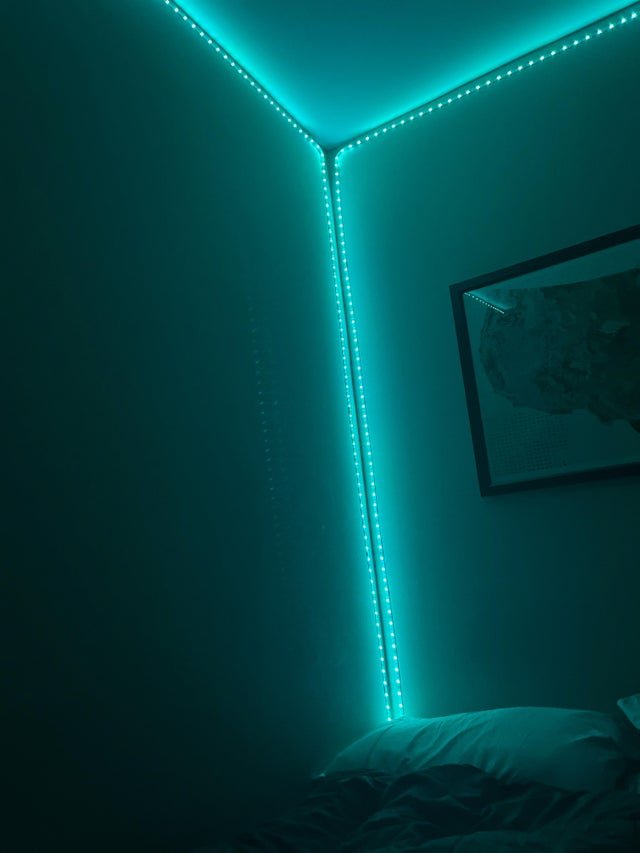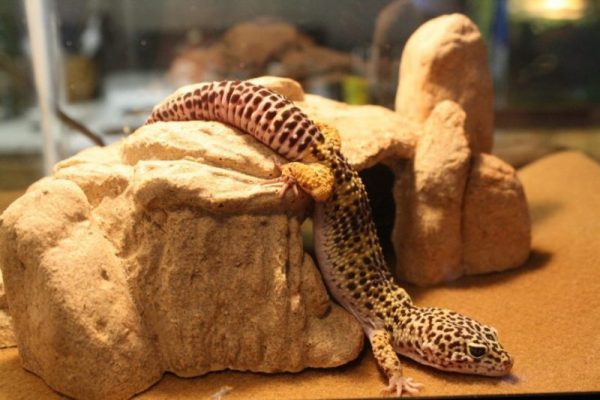Are Led Lights Safe for Leopard Geckos

If you have a leopard gecko, you may be wondering if LED lights are safe for them. The answer is yes! LED lights are actually a great option for leopard geckos because they emit very little heat and are energy-efficient.
Plus, they come in a variety of colors that can really make your leopard gecko’s enclosure look amazing.
There has been a lot of debate lately about whether or not LED lights are safe for leopard geckos. Some people say that they are fine, while others claim that the LEDs can cause health problems for the geckos. So, what is the truth?
Are LED lights safe for leopard geckos?The answer is yes, LED lights are safe for leopard geckos. In fact, many experts believe that LEDs are actually better for reptiles than traditional incandescent bulbs.
The reason why LEDs are so beneficial is because they emit very little heat and produce a much brighter light than incandescent bulbs. This means that your gecko will be able to see better and won’t be exposed to as much heat.So, if you’re looking for a safe and efficient way to light up your leopard gecko’s enclosure, then LEDs are definitely the way to go!

Credit: www.terrariumquest.com
Is Led Light Okay for Leopard Geckos?
Yes, LED light is perfectly safe for leopard geckos! In fact, many leopard gecko owners prefer to use LED lights because they emit very little heat and are more energy-efficient than traditional incandescent bulbs. Plus, LEDs come in a variety of colors, so you can choose the perfect lighting to show off your gecko’s beautiful patterns and colors.
Can I Use Led Lights for Reptiles?
Yes, you can use LED lights for reptiles. In fact, LEDs are becoming increasingly popular as a lighting option for reptiles, as they provide many benefits over traditional incandescent bulbs. Some of the advantages of using LEDs for reptile lighting include:
1. Increased Energy Efficiency: LEDs are much more energy-efficient than incandescent bulbs, meaning that they will help to reduce your electricity bills.2. Improved Light Quality: LED lights offer a full spectrum of light, which is beneficial for reptiles that need UVB rays for proper health and growth.3. Longer Lifespan: LEDs have a much longer lifespan than traditional bulbs, so you won’t have to replace them as often.
4. Reduced Heat Output: One of the biggest concerns with reptile lighting is the heat output, as too much heat can be harmful to your pet.
What Light is Safe for Leopard Geckos?
There is a lot of debate on what kind of light is safe for leopard geckos, with many people believing that any kind of light can be harmful to them. However, there is no definitive answer and it ultimately comes down to personal preference. Some leopard gecko owners use fluorescent bulbs, while others prefer incandescent bulbs.
Ultimately, as long as the light is not too bright and does not produce too much heat, it should be fine for your leopard gecko.
Do Lights Hurt Leopard Geckos Eyes?
No, lights don’t hurt leopard geckos eyes. In fact, they need some light to see properly. They are nocturnal animals though, so too much light can be harmful.
You should provide a basking spot with a UVB light for your leopard gecko so they can get the right amount of light during the day.
Do Leopard Geckos need Light?
Do Leopard Geckos Need Light at Night
Nocturnal animals are active during the night, while diurnal animals are active during the day. Many pet owners believe that because leopard geckos are nocturnal, they do not need light at night. However, this is not the case.
While leopard geckos may be more active at night, they still need light during the day.There are two types of lighting that are beneficial for leopard geckos: ultraviolet (UV) light and infrared (IR) light. UV light helps leopard geckos synthesize vitamin D3, which is essential for calcium absorption.
IR light helps leopard geckos thermoregulate their body temperature.Ideally, leopard geckos should have a 12-hour cycle of daylight and darkness. This can be accomplished with a basking bulb on one side of the enclosure and an infrared heat lamp on the other side.
The basking bulb should be turned off at night so that the leopard gecko can experience true darkness.
Leopard Gecko Lighting Requirements
As a reptile owner, it is important to understand the lighting requirements of your pet in order to provide them with the best possible care. Leopard geckos are no exception! These popular lizards come from arid regions of Asia and therefore do not require high levels of UVB radiation like many other reptiles.
In fact, too much UVB can be harmful to leopard geckos and may cause health problems such as metabolic bone disease.That being said, leopard geckos still need some level of UVB in order to synthesize vitamin D3, which is essential for calcium absorption. For this reason, it is recommended that leopard gecko owners use a low-output UVB bulb such as the Zoo Med Reptisun 5.0 or 10.0.
These bulbs should be placed on one side of the enclosure so that your gecko can choose whether or not to bask under them.In addition to UVB light, leopard geckos also need visible light in order to see properly and hunt for food. A fluorescent tube light placed over the top of the enclosure will provide both visible light and some UVB radiation (depending on the brand).
Alternatively, you could use two different types of bulbs – one for visible light and one for UVB – but this isn’t necessary as long as you have at least one source of each type of light in the enclosure.Leopard geckos are most active at night, so their lighting should be set up accordingly. If using a fluorescent tube light, it can be turned off at night or covered with a black sleeve to create a natural day/night cycle for your pet.
If using an incandescent bulb (such as a heat lamp), it should be turned off at night since these emit too much visible light and noUVB radiation. As long as your leopard gecko has access to both types of lighting during their day cycle, they will do just fine!
Led Light for Leopard Gecko
If you are looking for a way to add some extra light to your leopard gecko’s habitat, you may want to consider using a LED light. There are many benefits of using LED lights, and they can be a great addition to your pet’s home.LED lights last much longer than traditional incandescent bulbs, so you won’t have to worry about replacing them as often.
They also use less energy, which can help reduce your electric bill. And since they produce very little heat, they are a safer option for use with reptiles like leopard geckos.When choosing a LED light for your leopard gecko’s habitat, it is important to select one that emits UVB rays.
These rays are essential for helping your pet absorb calcium, and without them, your gecko could develop health problems over time. Be sure to choose a UVB bulb that is specifically designed for reptiles – not all LED bulbs emit UVB rays.You can find LED lights at most pet stores or online retailers that sell reptile supplies.
Prices will vary depending on the brand and type of light you choose. But overall, they are an affordable option that can provide many benefits for your leopard gecko’s health and well-being.
Are Red Lights Safe for Leopard Geckos?
Red light dangers in leopard geckos should not be ignored. Unlike humans, leopard geckos have sensitive eyes, making exposure to red lights potentially harmful. Experts advise using blue or purple lights for maintaining their day and night cycles instead. Prioritizing their safety is crucial for their overall well-being.
What Wattage Heat Lamp for Leopard Gecko
Leopard geckos are a popular pet reptile due to their docile nature and small size. They originate from warm, arid environments and so need a heat lamp in their enclosure to replicate these conditions. But what wattage heat lamp should you use for your leopard gecko?
The answer depends on the size of your leopard gecko’s enclosure. A general rule of thumb is to use a 50 watt heat bulb for every 10-20 gallons of space. So, if you have a 20 gallon enclosure, you would need a 100 watt heat bulb.
It’s also important to consider the ambient temperature of your home. If it’s already quite warm, you may not need such a high wattage bulb. You don’t want to overheat your leopard gecko!
Finally, make sure that your heat bulb is providing both light and heat. Leopard geckos need UVB rays in order to properly metabolize calcium. Without it, they can develop health problems like metabolic bone disease.
So look for a dual spectrum bulb that provides both light and heat, or combine a regular lightbulb with a separate UVB light source.
Conclusion
Are Led Lights Safe for Leopard Geckos?Leopard geckos are a popular pet, and many people are wondering if LED lights are safe for them. The answer is yes!
LED lights are actually a great option for leopard geckos, as they emit very little heat and provide good lighting for the reptile’s enclosure.There are a few things to keep in mind when using LED lights with leopard geckos, however. First, make sure that the light is not too bright – it should be dim enough that the gecko can comfortably bask in its warm glow.
Second, don’t place the light too close to the reptile’s tank, as this could cause the temperature inside to become too hot. Finally, consider investing in a timer so that the light automatically turns off after a certain amount of time. This will help ensure that your leopard gecko gets the right amount of light each day.